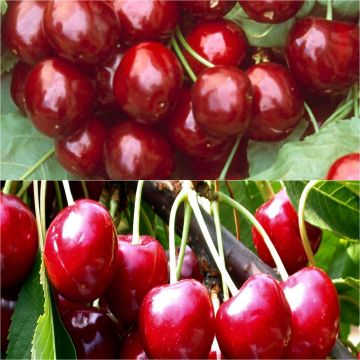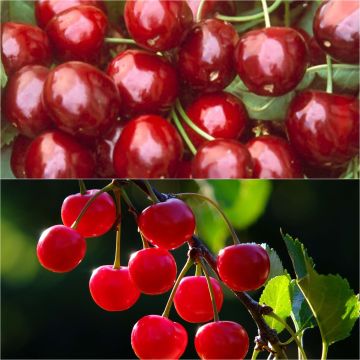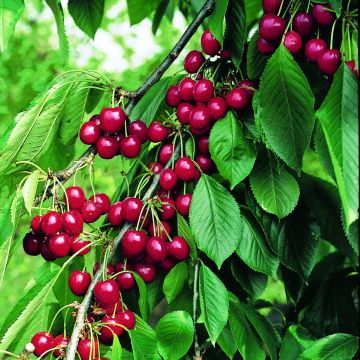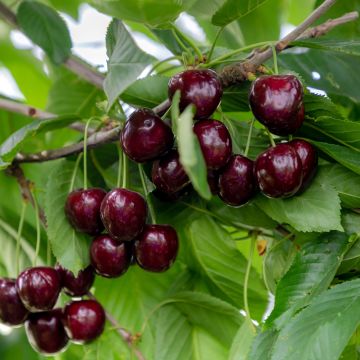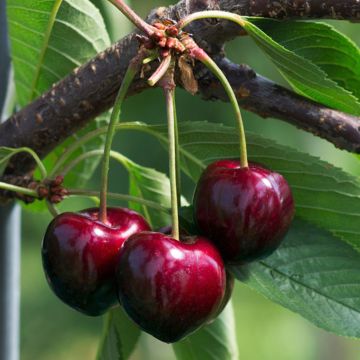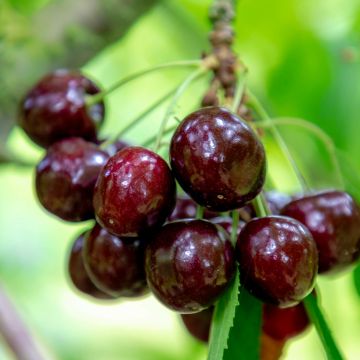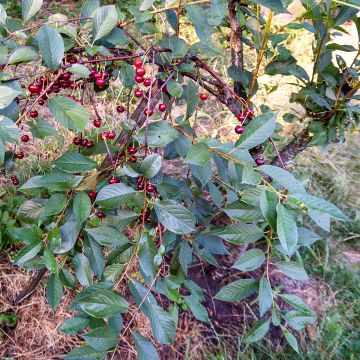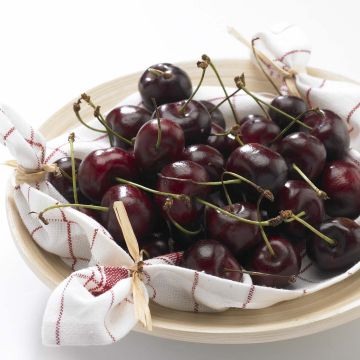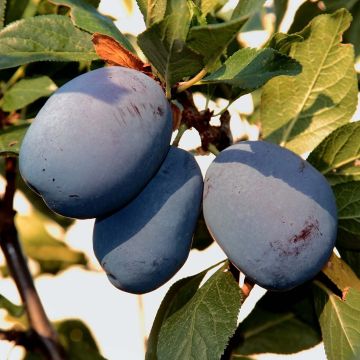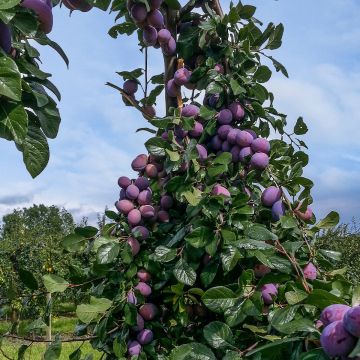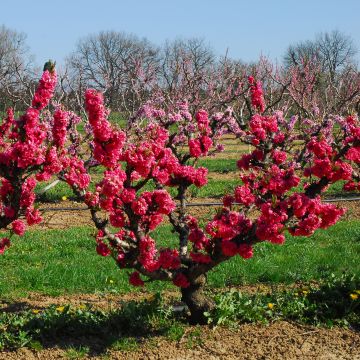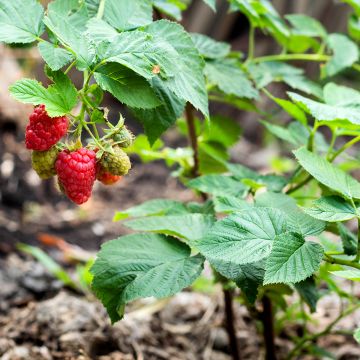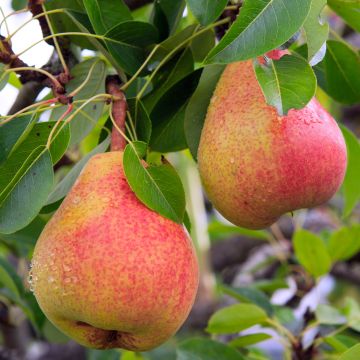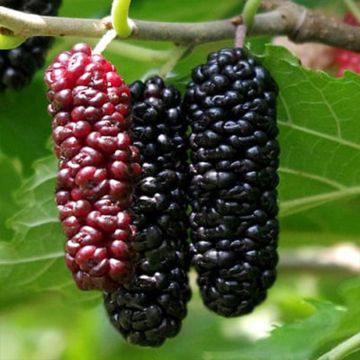

Cerisier nain Fruit me Cherry Me Lapins
Prunus cerasus Fruit Me Cherry Me Lapins - Tart Cherry Tree
Prunus cerasus Fruit Me Cherry Me Lapins
Sour Cherry, Tart Cherry, Dwarf Cherry, Morello Cherry
Special offer!
Receive a €20 voucher for any order over €90 (excluding delivery costs, credit notes, and plastic-free options)!
1- Add your favorite plants to your cart.
2- Once you have reached €90, confirm your order (you can even choose the delivery date!).
3- As soon as your order is shipped, you will receive an email containing your voucher code, valid for 3 months (90 days).
Your voucher is unique and can only be used once, for any order with a minimum value of €20, excluding delivery costs.
Can be combined with other current offers, non-divisible and non-refundable.
Home or relay delivery (depending on size and destination)
Schedule delivery date,
and select date in basket
This plant carries a 6 months recovery warranty
More information
We guarantee the quality of our plants for a full growing cycle, and will replace at our expense any plant that fails to recover under normal climatic and planting conditions.
Description
The Fruit Me Cherry Me Cherry Tree Lapins is characterised by its amazing ability to adapt its development to the amount of soil available to it. It is suitable for gardens with limited space, for cultivation in pots on balconies or terraces, or for creating a small fruit hedge. Its small size also makes picking easier. With a quick fruiting, it offers a harvest, from the first years, of beautiful cherries, with a large size, measuring 2.5 to 3 cm (1in) in diameter, heart-shaped. Their thin, shiny skin is orange-red, becoming bright red when ripe. The flesh is of excellent quality, juicy, firm, melting, crisp, sweet, subtly acidic, and fragrant. The Lapins variety can be consumed when barely ripe. This dwarf cherry tree, hardy (down to -20°C), resistant to diseases, and requiring no pruning, is easy to grow and almost maintenance-free. Self-fertile, it can self-pollinate, but the presence of another cherry tree flowering at the same time will increase production.
Prunus cerasus, commonly known as the Common Cherry Tree, belongs to the Rosaceae family. It is native to Europe, Western Asia, and North Africa, and has been present in Europe since the Neolithic period (Polished Stone Age). In France, cultivation began in the Middle Ages, where it was appreciated for its fruits and wood. It was in the 17th century that it colonized the largest orchards in the country. In the 18th century, Louis XV encouraged and promoted the discovery of new varieties. The Lapins variety is the result of cross-breeding between the 'Stella' and 'Van' varieties, obtained by Karl Lapins in 1965, in Canada, at the Summerland Station in British Columbia.
The Fruit Me Cherry Me Lapins variety is part of a very innovative series of semi-dwarf fruit trees, recently developed in Spain. The grafting technique, using a very specific and latest generation rootstock, allows this fruit tree to adapt to the available soil volume while ensuring high-quality fruit production from the first years of cultivation. This dwarf cherry tree has the ability to adapt its growth depending on the cultivation location. In open ground, it develops a spreading, semi-upright habit, with well-branched and well-aerated branching, reaching a height of about 2 to 2.50 m (7 to 8ft) at maturity, with a spread of 1.5 m (5ft). In a pot, it will not exceed 1.50 m (5ft) in height and 1 m (3ft) in width.
Its deciduous foliage consists of leaves measuring 5 to 7 cm (2 to 3in) in length, alternate, obovate, irregularly dentate, shiny green, turning brown-orange in autumn. The semi-late flowering occurs around mid-April, before the appearance of the leaves, which can expose it to late spring frosts. The pure white flowers, measuring 1.5 to 2.5 cm (1in) in diameter, are single and grouped in clusters. They can be destroyed by frost from -2 to -3°C, so it is recommended to plant cherry trees in sheltered locations, west-facing, and protected from cold winds in regions with late frosts. However, the very abundant flowering often leads to satisfactory fruiting. It is a remarkably decorative flowering in spring, and particularly attractive to bees and butterflies. This hardy tree, which can withstand temperatures around -20°C, is suitable for cultivation in all regions. It is self-fertile, and the flowers can self-pollinate, so it does not require a companion to bear fruit, but the presence of another cherry tree variety nearby will increase production. Moreover, the pollen of the Lapins variety has the ability to pollinate several other varieties, making it a universal pollinator.
The Fruit Me Cherry Me Lapins Cherry Tree is a very productive variety, with quick fruiting, around 2 to 3 years, reaching optimal productivity after 5 to 6 years. The harvest, uniform and abundant, may show a tendency for alternate bearing, meaning that a year of high productivity may be followed by a year of lower yield. The fruit is attached to the branch by a relatively short stalk measuring 3 to 4 cm (1 to 2in) in length. Harvesting begins around mid-June and continues until mid-July. It is important to pick the fruits only when they are ripe, as they do not ripen further, and with their stalks to ensure good storage. Cherries are quite fragile, so they should be harvested delicately.
Very juicy and sweet, these cherries are delicious when eaten fresh. In cooking, they reveal all their flavors in the preparation of clafoutis, cakes, crumbles or tarts, fruit salads, and as accompaniments to savory dishes with white meats (turkey, chicken, veal, duck, etc.). They are also perfect for making jams, preserved in syrup, or canned. Their content of vitamins A, C, and E, phenolic antioxidants, calcium, copper, along with a significant amount of iron, their richness in trace elements and fibers, make cherries a health asset. The fruits can only be stored for a few days in a cool place or in the refrigerator. They can also be frozen after being washed, dried, stemmed, and pitted.
Very popular for its fruits, the cherry tree finds its place in the garden for the enjoyment of young and old. Among a very wide range of cherry trees, it is easy to find the variety that best suits one's desires or needs. This Mini Cherry Tree, Cherry Me Lapins, like all the fruit trees in the Fruit Me® range, is also easy to grow, hardy, reliable, and less susceptible to diseases, while allowing the creation of a miniature orchard on the patio or balcony.
Prunus cerasus Fruit Me Cherry Me Lapins - Tart Cherry Tree in pictures
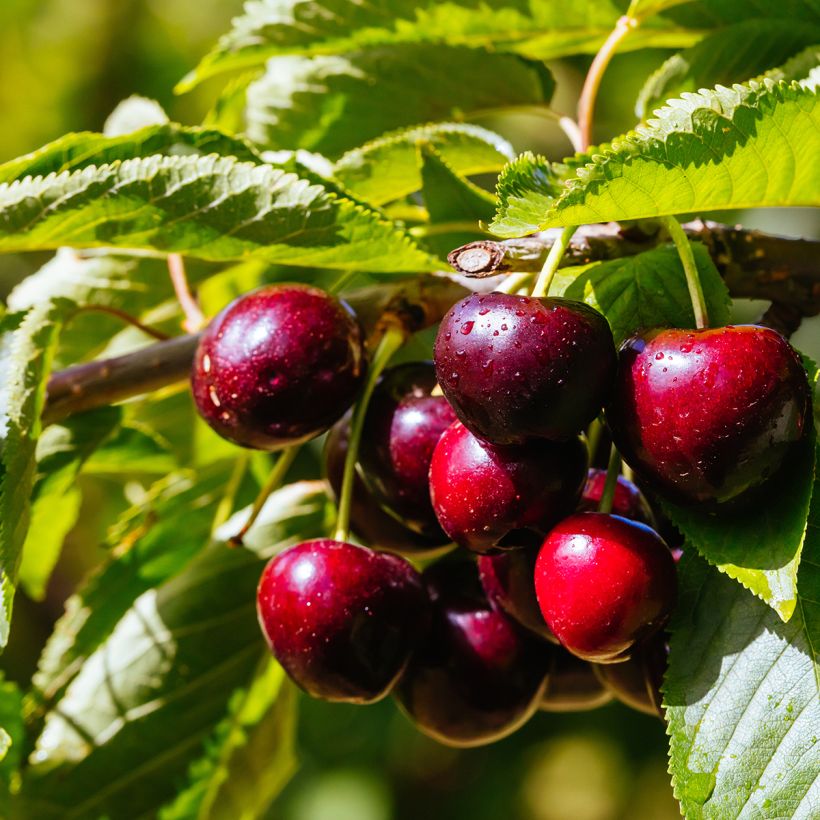

Plant habit
Fruit
Flowering
Foliage
Botanical data
Prunus
cerasus
Fruit Me Cherry Me Lapins
Rosaceae
Sour Cherry, Tart Cherry, Dwarf Cherry, Morello Cherry
Cultivar or hybrid
Other Cherry trees
View all →Planting and care
Easy to grow, the Cherry Fruit Me Cherry Me grows in any type of soil, neutral, slightly acidic or slightly chalky. It appreciates fresh, light soils and dislikes heavy and clay soils. Choose a sunny exposure. To limit the risk of late frosts on the flowers, it is recommended to plant the Cherry Tree in a sheltered location, facing west and protected from cold winds in regions that experience spring frosts. Planting is preferably done in autumn or alternatively in winter, outside the freezing period. If you plant several plants, space them 2 to 3 metres (7 to 10 feet) apart for dwarf varieties.
Loosen the soil deeply, remove stones and unwanted weeds. Add some sand to improve drainage. Dig a hole 4 to 5 times the volume of the root ball. Make sure to separate the subsoil and the topsoil. Mix crushed horn or well-rotted compost or potting soil with the subsoil and pour this mixture into the planting hole. Install a stake. Place the root ball, cover with topsoil and firm it down. Water thoroughly (about 10 litres). Position your tie system, crossing it in the shape of an 8, so that the trunk and the stake do not rub against each other.
During cultivation, watering is not necessary except in case of high temperatures. Mulch at the base to keep cool in summer. Protect your harvest by installing, as desired, a bird net, aluminum foil or old CDs.
For container planting : place a layer of gravel or clay balls at the bottom of the pot to facilitate drainage. Add a layer of soil and then place the plant and cover with a mixture of 2/3 garden soil, 1/3 potting soil or well-rotted compost. Every spring, remove the top layer and replace it with fresh potting soil. Water regularly and moderately. At the end of autumn, protect the pot with insulation before winter frosts.
The cherry tree can be subject to various diseases and pests. Against gray rot (velvety rot on fruits) and brown rot (wilting of flowers and rotting of fruits on the tree), remove and burn affected parts as a curative measure and spray with Bordeaux mixture or decoctions of horsetail or garlic as a preventive measure, at the beginning of spring and in autumn. Against bacterial canker (wilting of floral clusters, brown spots, bark deformation), spray with Bordeaux mixture. As for pests, the cherry fruit fly or fruit worm can be controlled preventively by installing yellow cardboard discs covered with glue in spring, or pheromone traps (trapping male insects), or a Drosophila trap, which can be easily made from a plastic bottle. In case of black aphid attack, spray a mixture of water and black soap or water and vegetable oil.
Planting period
Intended location
Care
Planting & care advice
This item has not been reviewed yet - be the first to leave a review about it.
Similar products
Haven't found what you were looking for?
Hardiness is the lowest winter temperature a plant can endure without suffering serious damage or even dying. However, hardiness is affected by location (a sheltered area, such as a patio), protection (winter cover) and soil type (hardiness is improved by well-drained soil).

Photo Sharing Terms & Conditions
In order to encourage gardeners to interact and share their experiences, Promesse de fleurs offers various media enabling content to be uploaded onto its Site - in particular via the ‘Photo sharing’ module.
The User agrees to refrain from:
- Posting any content that is illegal, prejudicial, insulting, racist, inciteful to hatred, revisionist, contrary to public decency, that infringes on privacy or on the privacy rights of third parties, in particular the publicity rights of persons and goods, intellectual property rights, or the right to privacy.
- Submitting content on behalf of a third party;
- Impersonate the identity of a third party and/or publish any personal information about a third party;
In general, the User undertakes to refrain from any unethical behaviour.
All Content (in particular text, comments, files, images, photos, videos, creative works, etc.), which may be subject to property or intellectual property rights, image or other private rights, shall remain the property of the User, subject to the limited rights granted by the terms of the licence granted by Promesse de fleurs as stated below. Users are at liberty to publish or not to publish such Content on the Site, notably via the ‘Photo Sharing’ facility, and accept that this Content shall be made public and freely accessible, notably on the Internet.
Users further acknowledge, undertake to have ,and guarantee that they hold all necessary rights and permissions to publish such material on the Site, in particular with regard to the legislation in force pertaining to any privacy, property, intellectual property, image, or contractual rights, or rights of any other nature. By publishing such Content on the Site, Users acknowledge accepting full liability as publishers of the Content within the meaning of the law, and grant Promesse de fleurs, free of charge, an inclusive, worldwide licence for the said Content for the entire duration of its publication, including all reproduction, representation, up/downloading, displaying, performing, transmission, and storage rights.
Users also grant permission for their name to be linked to the Content and accept that this link may not always be made available.
By engaging in posting material, Users consent to their Content becoming automatically accessible on the Internet, in particular on other sites and/or blogs and/or web pages of the Promesse de fleurs site, including in particular social pages and the Promesse de fleurs catalogue.
Users may secure the removal of entrusted content free of charge by issuing a simple request via our contact form.
The flowering period indicated on our website applies to countries and regions located in USDA zone 8 (France, the United Kingdom, Ireland, the Netherlands, etc.)
It will vary according to where you live:
- In zones 9 to 10 (Italy, Spain, Greece, etc.), flowering will occur about 2 to 4 weeks earlier.
- In zones 6 to 7 (Germany, Poland, Slovenia, and lower mountainous regions), flowering will be delayed by 2 to 3 weeks.
- In zone 5 (Central Europe, Scandinavia), blooming will be delayed by 3 to 5 weeks.
In temperate climates, pruning of spring-flowering shrubs (forsythia, spireas, etc.) should be done just after flowering.
Pruning of summer-flowering shrubs (Indian Lilac, Perovskia, etc.) can be done in winter or spring.
In cold regions as well as with frost-sensitive plants, avoid pruning too early when severe frosts may still occur.
The planting period indicated on our website applies to countries and regions located in USDA zone 8 (France, United Kingdom, Ireland, Netherlands).
It will vary according to where you live:
- In Mediterranean zones (Marseille, Madrid, Milan, etc.), autumn and winter are the best planting periods.
- In continental zones (Strasbourg, Munich, Vienna, etc.), delay planting by 2 to 3 weeks in spring and bring it forward by 2 to 4 weeks in autumn.
- In mountainous regions (the Alps, Pyrenees, Carpathians, etc.), it is best to plant in late spring (May-June) or late summer (August-September).
The harvesting period indicated on our website applies to countries and regions in USDA zone 8 (France, England, Ireland, the Netherlands).
In colder areas (Scandinavia, Poland, Austria...) fruit and vegetable harvests are likely to be delayed by 3-4 weeks.
In warmer areas (Italy, Spain, Greece, etc.), harvesting will probably take place earlier, depending on weather conditions.
The sowing periods indicated on our website apply to countries and regions within USDA Zone 8 (France, UK, Ireland, Netherlands).
In colder areas (Scandinavia, Poland, Austria...), delay any outdoor sowing by 3-4 weeks, or sow under glass.
In warmer climes (Italy, Spain, Greece, etc.), bring outdoor sowing forward by a few weeks.































